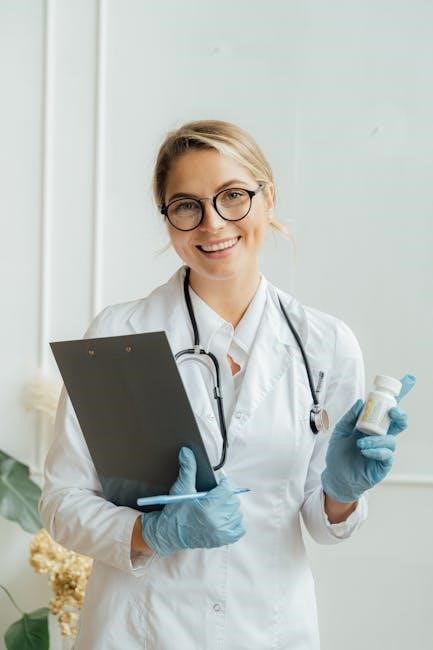Polyethylene glycol (PEG) is a widely used, safe, and effective bowel cleansing agent. It works as an osmotic laxative, helping clear the colon for medical procedures by flushing out stool and reducing complications. PEG solutions, often combined with electrolytes, are non-irritating and preferred for their ability to maintain fluid balance during preparation.
1.1 What is Polyethylene Glycol (PEG)?
Polyethylene glycol (PEG) is a non-absorbable, water-soluble polymer commonly used as an osmotic laxative for bowel cleansing. It works by drawing fluid into the colon, softening stool, and promoting bowel movements. PEG is combined with electrolytes to maintain fluid and electrolyte balance during preparation. It is odorless, tasteless, and non-irritating, making it a well-tolerated option for colonoscopy preparation. PEG is available in various formulations, including PEG-3350, which is specifically designed for bowel cleansing. Its effectiveness lies in its ability to flush out stool without being absorbed by the body, ensuring a clean colon for medical procedures. PEG is widely recommended for its safety and efficacy in both adult and pediatric populations.
1.2 Importance of Bowel Cleansing for Medical Procedures
2.1 Indications for PEG Use
Polyethylene glycol (PEG) is primarily indicated for bowel cleansing in preparation for colonoscopy and other diagnostic procedures, such as barium enema X-ray examinations. It is effective for clearing the colon of stool, ensuring accurate visualization during medical imaging. PEG is also used in patients with chronic constipation to facilitate bowel movements. Its osmotic action makes it suitable for individuals requiring gentle yet thorough cleansing. PEG-based solutions are often prescribed for adults and, in some cases, pediatric patients, under medical supervision. The solution is particularly beneficial for patients who require a non-invasive and tolerable method of bowel preparation. Its ability to maintain electrolyte balance makes it a preferred choice for pre-procedural cleansing in various clinical settings;
Patient Selection for PEG-Based Bowel Cleansing
Patient selection focuses on adults and children requiring colonoscopy prep, particularly those with chronic constipation. PEG is safe and effective, ensuring proper electrolyte balance during cleansing.
Polyethylene glycol (PEG) is primarily indicated for bowel cleansing in preparation for colonoscopy, barium enema X-ray examinations, and other imaging procedures requiring a clean colon. It is ideal for adults and children with chronic constipation, as it effectively flushes out stool without causing irritation. PEG is also used for patients undergoing colon capsule endoscopy or other procedures needing high-quality bowel preparation. The solution is administered orally, typically in split doses, to ensure thorough cleansing while minimizing side effects. PEG’s osmotic properties make it a preferred choice for maintaining proper electrolyte balance and preventing dehydration. Its effectiveness and safety profile make it suitable for a wide range of patients needing reliable bowel cleansing before diagnostic or therapeutic interventions.
2.2 Contraindications and Special Considerations
PEG is contraindicated in patients with severe gastrointestinal obstructions, active inflammatory bowel disease, or hypersensitivity to polyethylene glycol. It should be used cautiously in individuals with kidney dysfunction or heart conditions. Special considerations include monitoring electrolyte levels, as PEG can cause shifts in sodium and potassium. Patients with a history of dehydration or electrolyte imbalances require close supervision. Additionally, PEG is not recommended for those with severe nausea or vomiting, as it may prevent adequate ingestion; Pregnant or breastfeeding women should consult their healthcare provider before using PEG. Nurses must ensure proper hydration and monitor for signs of dehydration or electrolyte disturbances during bowel preparation. Adherence to these guidelines ensures safe and effective use of PEG for bowel cleansing.
Preparation Process for PEG Administration
Patients begin with a clear liquid diet, then mix the PEG solution with water or electrolyte-rich fluids. Ingest 250-300 ml every 10 minutes over 2-3 hours.
3.1 Preparing the PEG Solution
Preparing the PEG solution involves mixing the powdered or granulated form with water according to the manufacturer’s instructions. Typically, one package of PEG is dissolved in 1 liter of water. The solution should be stirred thoroughly until the powder is fully dissolved. For better taste, it can be mixed with clear fluids like apple or grape juice, provided they do not contain pulp or sediment. The mixture should be prepared no more than 24 hours in advance to ensure effectiveness. It’s important to chill the solution in the refrigerator before consumption to improve palatability. Patients should be advised to mix the solution just before starting the bowel preparation to maximize its cleansing effect.
3.2 Starting the Clear Liquid Diet
Starting a clear liquid diet is a crucial step before bowel cleansing with PEG. Patients should consume only clear, non-red, and non-purple fluids to ensure the colon remains visible during procedures. Allowed liquids include water, clear broths, electrolyte-rich beverages, and select fruit juices without pulp. Avoid solid foods, dairy, and anything with seeds or nuts. Patients should begin the clear liquid diet at least 24 hours before the procedure, gradually transitioning from light meals to only liquids. This step helps reduce residue in the colon, improving the effectiveness of PEG cleansing. Adherence to this diet is essential for achieving optimal bowel preparation and ensuring accurate medical results.
3.3 Mixing and Ingesting the Solution
Mixing and ingesting the PEG solution correctly is essential for effective bowel cleansing. The solution should be prepared by dissolving the PEG powder in water or an electrolyte-rich liquid like Gatorade to maintain fluid balance. Patients should drink 250-300 ml of the solution every 10 minutes over 2-3 hours, or as directed by their healthcare provider. It is important to finish the entire solution to ensure complete cleansing. Bowel movements typically begin within 1 hour of ingestion. Patients should stay hydrated and avoid solid foods during this process. The solution may be chilled to improve taste, but it should not be mixed with other beverages. Proper ingestion ensures the colon is clear for medical procedures, and patients should follow the instructions carefully to avoid complications.

Monitoring the Patient During PEG Use
Monitor patients for onset of bowel movements, typically within 1 hour, and signs of effective cleansing, such as clear stool. Manage side effects like nausea or dehydration promptly.
4.1 Expected Onset of Bowel Movements
Patients typically experience the onset of bowel movements within 1 hour after starting the PEG solution. The laxative effect of PEG leads to diarrhea or frequent bowel movements, which are expected and necessary for effective cleansing. Nurses should inform patients to stay near a toilet during this time. The frequency and liquidity of stools will increase, indicating the solution is working. It’s important to reassure patients that these effects are temporary and resolve once the preparation is complete. Monitoring for any delays or unusual symptoms, such as severe abdominal pain, is crucial. Proper hydration should also be emphasized to prevent dehydration during this process.
4.2 Signs of Effective Cleansing
Effective bowel cleansing with PEG is indicated by the presence of clear or yellow liquid stools, signaling that the colon is emptied of solid matter. Patients should be advised to continue the regimen until this endpoint is reached, as it confirms the colon is adequately prepared for procedures like colonoscopy. Nurses should emphasize that the goal is to achieve stool that resembles clear water or has a light yellow tint, free from particles. This ensures optimal visibility during medical examinations. Patients should report any difficulty in reaching this stage, as it may indicate incomplete cleansing. Monitoring for consistent, watery bowel movements is essential to confirm the effectiveness of the PEG preparation.
4.3 Managing Side Effects
Common side effects of PEG include nausea, bloating, and abdominal cramps. To manage these, patients should be encouraged to drink the solution slowly and in smaller volumes. Staying hydrated with clear fluids can help alleviate discomfort. If nausea occurs, taking a short break before resuming the regimen may reduce symptoms. Flavor enhancers, like adding lemon juice, can improve tolerability. Patients should be reassured that these side effects are temporary and generally mild. Severe or persistent symptoms, such as vomiting or chest pain, should be reported to healthcare providers promptly. Proper adherence to the regimen and hydration are key to minimizing discomfort while ensuring effective cleansing.

Tips for Improving Patient Tolerance
Encourage patients to stay hydrated with clear fluids and consider chilling the solution for better taste. Drinking slowly and taking short breaks can reduce nausea. Adding flavor enhancers like lemon juice may improve compliance. Suggest distractions, such as watching TV, to make the process less daunting. Emphasize the importance of completing the regimen for effective cleansing.
5.1 Staying Hydrated
Staying hydrated is crucial during bowel cleansing with polyethylene glycol (PEG). Patients should drink clear liquids, such as water, clear broths, or electrolyte-rich beverages, to prevent dehydration. It is recommended to consume at least 8-10 glasses of fluid per day, with a focus on clear liquids the day before and the day of the procedure. Avoiding red or purple liquids is important to ensure accurate colonoscopy results. Chilling the PEG solution in the refrigerator before consumption may improve its palatability. Encourage patients to sip fluids slowly to reduce nausea and discomfort. Proper hydration helps the PEG solution work effectively, ensuring thorough bowel cleansing and minimizing side effects like dizziness or fatigue.
5.2 Reducing Nausea and Discomfort
Nausea and discomfort are common side effects of PEG ingestion. To minimize these, patients should take small sips of the solution over time rather than drinking it quickly. Chilling the solution before consumption may improve tolerability. Patients should avoid lying down immediately after ingestion and may benefit from taking ginger products or crackers to alleviate nausea. Encouraging patients to rest in an upright position and distracting themselves with calm activities can also help reduce discomfort. Staying hydrated with clear fluids, as recommended, further helps mitigate side effects. These strategies aim to enhance patient comfort and adherence to the bowel cleansing regimen;
5.3 Flavor Enhancements for Better Compliance
Improving the flavor of PEG solutions can significantly enhance patient compliance. Adding lemon or orange slices to the solution may make it more palatable. Chilling the mixture in the refrigerator before consumption can also reduce the unpleasant taste. Patients can sip the solution slowly through a straw to minimize direct contact with the taste buds. Additionally, mixing the PEG with a small amount of clear fruit juice, such as apple or grape juice, may help mask the flavor. However, it’s important to avoid adding red or purple liquids to prevent interfering with the colonoscopy results. These small adjustments can make the bowel cleansing process more tolerable and encourage patients to complete the regimen as instructed.

Patient Education and Instructions
Effective patient education is crucial for successful bowel cleansing. Nurses should provide clear, verbal and written instructions, emphasizing the importance of adhering to the PEG regimen for optimal results.
6.1 Verbal and Written Instructions
Providing both verbal and written instructions ensures patients understand the bowel cleansing process. Nurses should explain how to prepare and ingest the PEG solution, emphasizing the importance of completing the full dose. Clear, step-by-step guidelines help patients stay on track, while written materials serve as a reference. Instructions should include timing, dosage, and expected outcomes, such as the onset of bowel movements. Addressing common concerns, like nausea or diarrhea, can improve patient compliance. Ensuring patients understand the rationale behind each step fosters cooperation and reduces anxiety, ultimately leading to a more effective cleansing process.
6.2 Importance of Adherence to the Regimen
Adherence to the PEG regimen is crucial for effective bowel cleansing. Incomplete preparation can compromise procedure accuracy and safety. Patients must follow the prescribed timeline and dosage to ensure proper colon cleansing. Skipping doses or deviating from instructions can lead to inadequate results, potentially requiring procedure rescheduling. Emphasizing the role of each step helps patients understand the necessity of strict compliance. Nurses should reinforce the importance of finishing the entire solution and adhering to dietary restrictions, such as avoiding solid foods and red liquids. Proper adherence ensures optimal cleansing, minimizing complications and enhancing diagnostic outcomes.

Comparative Effectiveness of PEG
PEG is a highly effective bowel cleansing agent, preferred over other solutions due to its safety, efficacy, and low side-effect profile, making it a leading choice for colon preparation.
7.1 PEG vs. Other Bowel Cleansing Agents
Polyethylene glycol (PEG) stands out among bowel cleansing agents due to its superior efficacy and tolerability. Unlike sodium phosphate-based solutions, PEG does not cause significant electrolyte imbalances, making it safer for a broader patient population. Studies have shown that PEG-based regimens often result in better patient satisfaction compared to other agents like sodium picosulfate or magnesium citrate. Additionally, PEG solutions are less likely to cause gastrointestinal discomfort, such as nausea or bloating, which are common with other laxatives. This makes PEG a preferred choice for both healthcare providers and patients, ensuring effective bowel preparation while maintaining patient comfort and safety.
7.2 Studies on Patient Satisfaction and Efficacy
Research consistently highlights high patient satisfaction and efficacy with polyethylene glycol (PEG)-based bowel cleansing. Studies demonstrate that PEG solutions achieve excellent colon cleansing, enabling accurate diagnostic results during procedures like colonoscopy. Patients report better tolerability with PEG compared to other agents, citing fewer side effects such as nausea and abdominal discomfort. Split-dosing regimens, where PEG is taken in two separate sessions, have further enhanced patient compliance and satisfaction. Clinical trials also show that PEG-based preparations reduce the risk of inadequate bowel cleansing, a critical factor for procedure success. These findings underscore PEG as a reliable and patient-friendly option for effective bowel preparation.
Polyethylene glycol (PEG) is a safe and effective bowel cleansing agent, ensuring optimal preparation for medical procedures. High patient satisfaction and proper nursing instructions enhance its success.
8.1 Summary of Key Points
Polyethylene glycol (PEG) is a safe and effective bowel cleansing agent, widely used for colonoscopy preparation. It acts as an osmotic laxative, flushing out stool without causing irritation. Nurses should instruct patients to follow a clear liquid diet before starting PEG, drink the solution as directed (typically 250-300 ml every 10 minutes), and expect bowel movements within 1-2 hours. Proper hydration and tips to reduce nausea can improve tolerance; Adherence to the regimen ensures optimal cleansing, crucial for accurate medical procedures. Patient education, including verbal and written instructions, is essential for successful preparation.
8.2 Final Tips for Successful Bowel Cleansing
- Start with a clear liquid diet 24-48 hours before the procedure to ensure proper preparation.
- Drink the PEG solution in intervals (e.g., 250-300 ml every 10 minutes) to avoid overwhelming the stomach.
- Stay hydrated by drinking additional clear fluids to prevent dehydration.
- Consider chilling the solution to improve taste and reduce nausea.
- Plan to stay near a bathroom, as bowel movements typically begin within 1-2 hours of starting PEG.
- Complete the entire solution as directed to achieve optimal cleansing.
- Follow all instructions precisely to ensure the procedure’s success and safety.
By adhering to these tips, patients can achieve effective bowel cleansing and improve the likelihood of a successful medical procedure.
